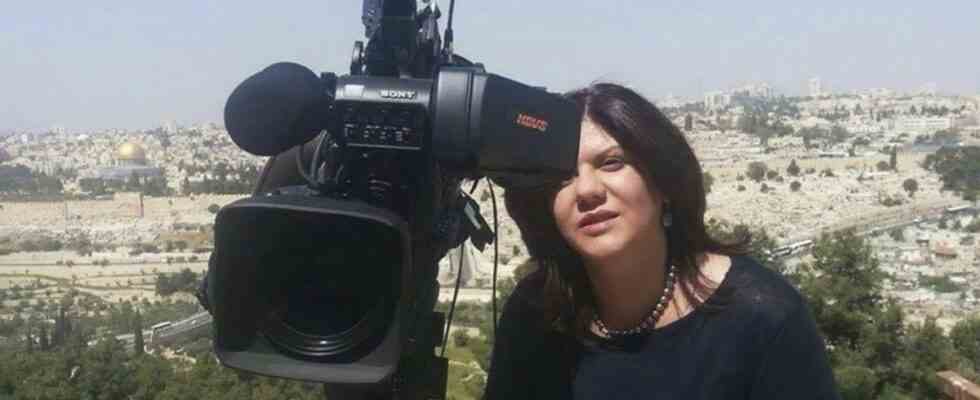When TV journalist Shirin Abu Akleh was hit by a bullet while working in the West Bank city of Jenin on May 11, collapsed and died on the spot, blame was quickly laid. Militant Palestinians fired, said a spokesman for the Israeli military, which had been conducting an operation in the city’s refugee camp, which had been turbulent for weeks. A video taken near the road where Abu Akleh died seemed to support this claim – it showed a gunman shouting excitedly that someone had been hit.
On the Palestinian side and at Abu Akleh’s employer, quite a few spoke quickly of the “cold-blooded murder” of a journalist which was considered an icon in the Arab world: Born in Jerusalem to a Christian family, Abu Akleh has been reporting on the Middle East conflict for the Qatari news channel Al Jazeera since 1997 – even and especially when it became dangerous. That was already the case during the Second Intifada, and it was the same again on May 11, when Abu Akleh wanted to film with her team in Jenin, as part of a group of journalists, wearing helmets and protective vests with “PRESS” written in large letters . Almost as quickly as the mutual finger-pointing, Abu Akleh became a symbol in the Arab world, a martyr – her likeness adorning the mural, recreated in sand on the beaches of Gaza, placed in churches as a portrait.
However, a comprehensive investigation into the circumstances of his death never came about. The Palestinians refused to cooperate with the Israeli army, although the Israeli army soon withdrew its version of the possible course of events. However, the responsible military prosecutor did not want to initiate investigations, she explained just under a week after Abu Akleh’s death: Without an autopsy and without an examination of the deadly bullet, the chances of success are too small. From the point of view of the army, the indications that a crime had been committed were too low – “a clear determination of the source of the gunfire” was not possible.
Nevertheless, a month later, the events in the early morning of May 11 seem at least partially cleared up: it cannot be said with certainty whether Abu Akleh was shot at “directly and intentionally”. The Palestinian public prosecutor claims that – at least since the Gaza war in 2021, in which Israel’s air force bombed an office tower, where Al Jazeera and the Associated Press agency have their offices, the Palestinian side accuses Israel of targeting journalists. However, it can now be considered certain that the bullet that entered the head of the 51-year-old journalist was fired by an Israeli soldier – whether accidentally or intentionally.
Journalists took over the task that investigators and lawyers actually have. First, Abu Akleh’s employer, Al Jazeera, presented a video showing that Palestinian militants did not fire during the minutes in question. Then the group analyzed Bellingcat the process – with their analyzes of geodata, video and audio recordings, the digital forensic scientists have often provided decisive information for clarifying situations, for example when the flight MH-17 was shot down over eastern Ukraine, during the Syrian war and now during the Russian invasion of Ukraine which two sides blame each other. CNN and the AP news agency took on the case – and finally both presented in the past few days Washington Post as well as the New York Times the research of their investigative teams. In addition to evaluating data, the journalists also interviewed eyewitnesses, local residents, but also colleagues who, for security reasons, were moving in a group with Abu Akleh.
A Palestinian in Gaza City honors the killed journalist with a mural.
(Photo: MOHAMMED ABED/AFP)
the New York Times meticulously traces the last morning of Abu Akleh’s life, from the moment she awoke at 5:45 a.m. in her hotel in Jenin. And like colleagues from other media, the researchers came to the conclusion that the projectile that hit Abu Akleh in the neck exited the forehead and, deflected from the inside of the helmet, entered the head again, measuring 5.56 by 45 millimeters – a caliber that both sides use. However, the research team is certain that the fatal bullet was fired “from the approximate location of the Israeli army convoy” operating in Jenin at the time. “Most likely by a soldier from an elite unit” – Palestinian gunmen, on the other hand, were not around.
Media research is now increasing the pressure on Israel to investigate the case after all, or at least to hand over its own data to independent investigators – US lawmakers are demanding an investigation by the FBI, for example, because Abu Akleh was also an American citizen. However, that is unlikely, if only because the country is again faced with a political vacuum after the breakup of the previously governing coalition. The handling of a final report from another investigation that the Israeli authorities actually conducted into the death of Abu Akleh and submitted to the Minister of Public Security in mid-June also gives little hope of transparency.
When relatives and mourners wanted to transfer the body from the hospital in East Jerusalem, where the journalist had been autopsied, to the funeral service and to the cemetery, there were repulsive scenes: Israeli security forces probably wanted to prevent a crowd through the funeral procession that was difficult to control and went with batons and Stun grenades, the coffin with the corpse almost fell to the ground. According to the left-liberal Israeli newspaper hairnet, wanting to know the details of the report, Israel’s police are now reporting misconduct – but the report is not published, just as consequences are to be drawn: It was decided before the report was completed that the officers responsible could not expect any disciplinary measures.

